Business Activities Report: Processes, Quality, and Risk at ABC
VerifiedAdded on 2020/01/28
|17
|5822
|91
Report
AI Summary
This report provides a comprehensive analysis of managing business activities at ABC Company, focusing on various aspects of its operations. It begins by examining the interrelationship between different processes and functions, such as marketing, finance, and human resources, highlighting their interconnectedness and importance for organizational success. The report then delves into the methodology used to map processes within the company, illustrating how these processes are linked to corporate goals and objectives. It further explores the outputs of these processes and the elements necessary to build a quality gateway. The report also includes a personal development plan for an HR Executive, outlining strategies to promote goals and objectives, and recommendations for aligning resources using SMART objectives. It also discusses systems to achieve objectives efficiently and effectively, and how work activities meet the operational plan. The report also addresses quality management, risk assessment, and health and safety regulations, providing insights into how ABC Company manages and monitors these critical areas to ensure compliance and maintain a safe working environment. Finally, the report concludes with a discussion on the wider implications of proposed changes and improvements to align company targets with results.
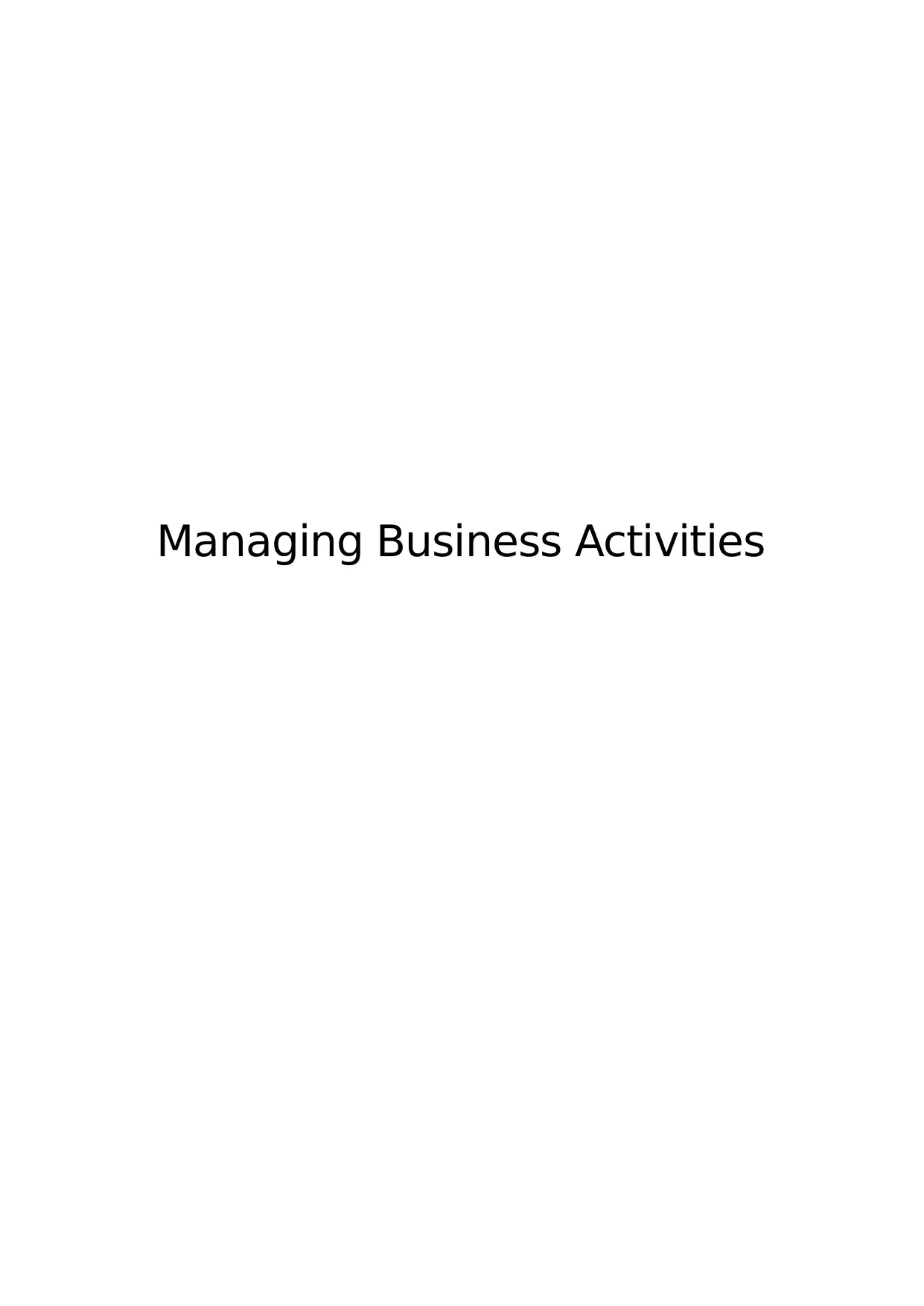
Managing Business Activities
Paraphrase This Document
Need a fresh take? Get an instant paraphrase of this document with our AI Paraphraser
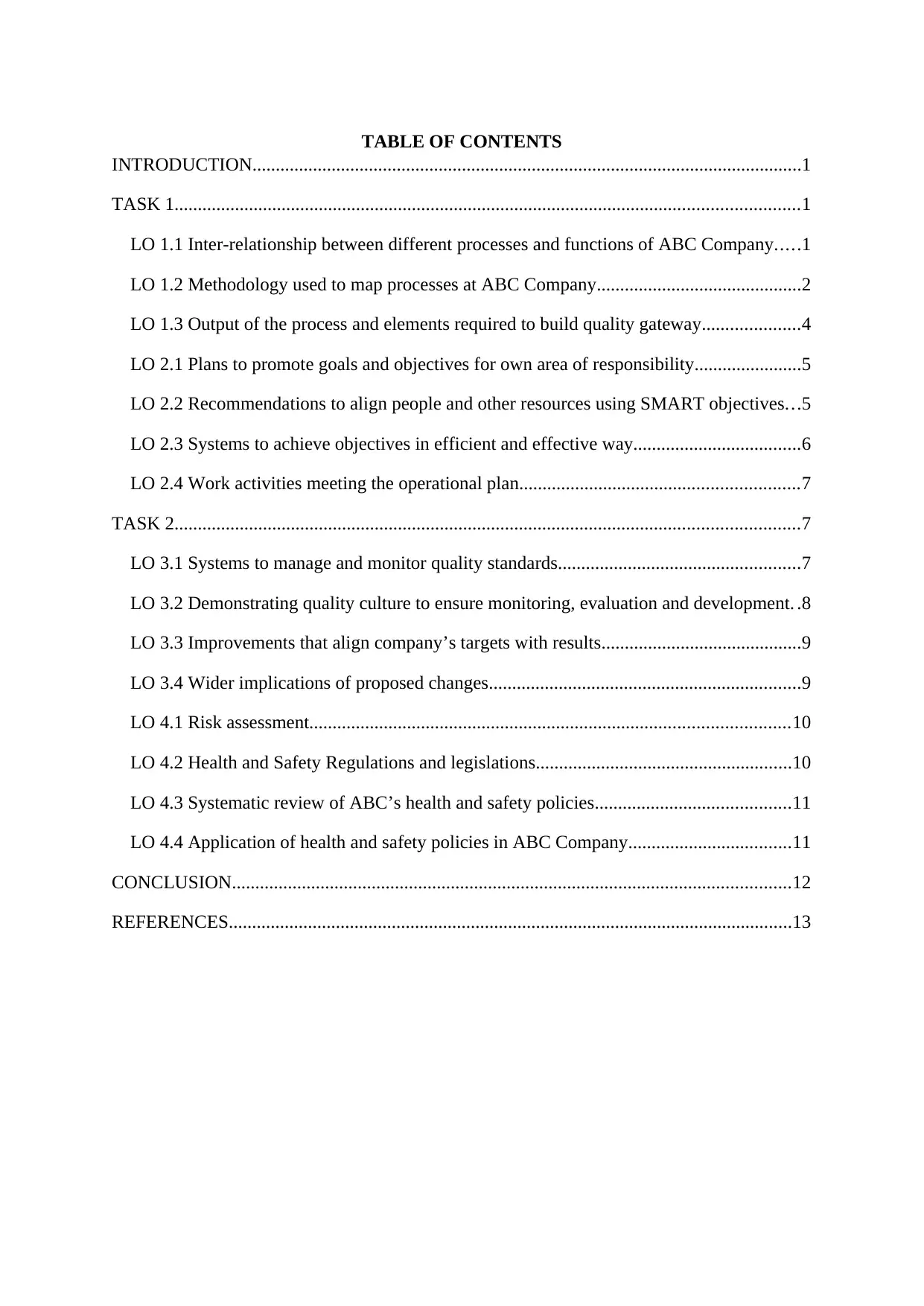
TABLE OF CONTENTS
INTRODUCTION......................................................................................................................1
TASK 1......................................................................................................................................1
LO 1.1 Inter-relationship between different processes and functions of ABC Company.....1
LO 1.2 Methodology used to map processes at ABC Company............................................2
LO 1.3 Output of the process and elements required to build quality gateway.....................4
LO 2.1 Plans to promote goals and objectives for own area of responsibility.......................5
LO 2.2 Recommendations to align people and other resources using SMART objectives...5
LO 2.3 Systems to achieve objectives in efficient and effective way....................................6
LO 2.4 Work activities meeting the operational plan............................................................7
TASK 2......................................................................................................................................7
LO 3.1 Systems to manage and monitor quality standards....................................................7
LO 3.2 Demonstrating quality culture to ensure monitoring, evaluation and development. .8
LO 3.3 Improvements that align company’s targets with results...........................................9
LO 3.4 Wider implications of proposed changes...................................................................9
LO 4.1 Risk assessment.......................................................................................................10
LO 4.2 Health and Safety Regulations and legislations.......................................................10
LO 4.3 Systematic review of ABC’s health and safety policies..........................................11
LO 4.4 Application of health and safety policies in ABC Company...................................11
CONCLUSION........................................................................................................................12
REFERENCES.........................................................................................................................13
INTRODUCTION......................................................................................................................1
TASK 1......................................................................................................................................1
LO 1.1 Inter-relationship between different processes and functions of ABC Company.....1
LO 1.2 Methodology used to map processes at ABC Company............................................2
LO 1.3 Output of the process and elements required to build quality gateway.....................4
LO 2.1 Plans to promote goals and objectives for own area of responsibility.......................5
LO 2.2 Recommendations to align people and other resources using SMART objectives...5
LO 2.3 Systems to achieve objectives in efficient and effective way....................................6
LO 2.4 Work activities meeting the operational plan............................................................7
TASK 2......................................................................................................................................7
LO 3.1 Systems to manage and monitor quality standards....................................................7
LO 3.2 Demonstrating quality culture to ensure monitoring, evaluation and development. .8
LO 3.3 Improvements that align company’s targets with results...........................................9
LO 3.4 Wider implications of proposed changes...................................................................9
LO 4.1 Risk assessment.......................................................................................................10
LO 4.2 Health and Safety Regulations and legislations.......................................................10
LO 4.3 Systematic review of ABC’s health and safety policies..........................................11
LO 4.4 Application of health and safety policies in ABC Company...................................11
CONCLUSION........................................................................................................................12
REFERENCES.........................................................................................................................13

TABLE OF FIGURES
Figure 1: Organizational Chart...................................................................................................2
Figure 2: Core Processes and Key Activities.............................................................................3
Figure 3: Process Map................................................................................................................4
Figure 1: Organizational Chart...................................................................................................2
Figure 2: Core Processes and Key Activities.............................................................................3
Figure 3: Process Map................................................................................................................4
⊘ This is a preview!⊘
Do you want full access?
Subscribe today to unlock all pages.

Trusted by 1+ million students worldwide
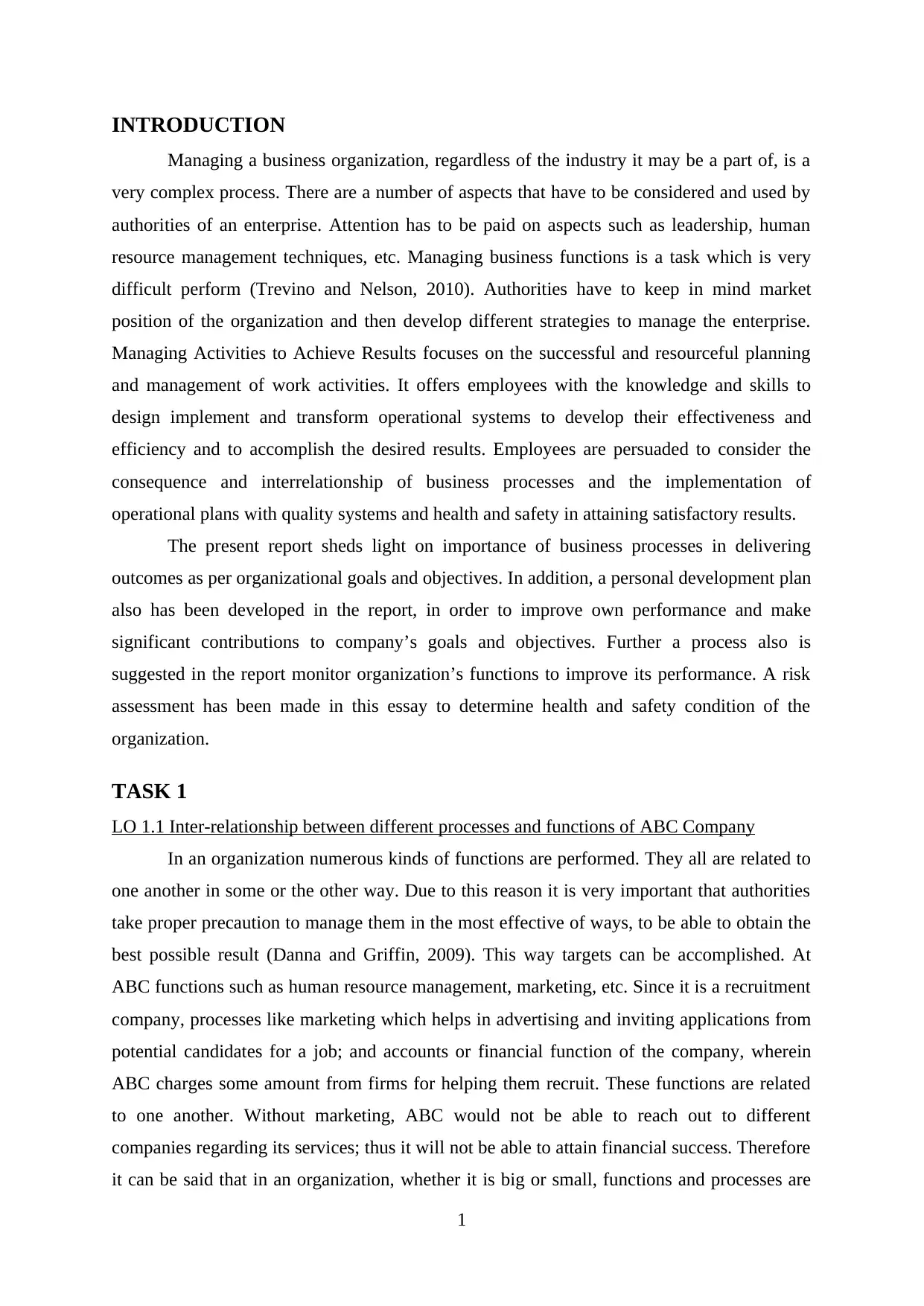
INTRODUCTION
Managing a business organization, regardless of the industry it may be a part of, is a
very complex process. There are a number of aspects that have to be considered and used by
authorities of an enterprise. Attention has to be paid on aspects such as leadership, human
resource management techniques, etc. Managing business functions is a task which is very
difficult perform (Trevino and Nelson, 2010). Authorities have to keep in mind market
position of the organization and then develop different strategies to manage the enterprise.
Managing Activities to Achieve Results focuses on the successful and resourceful planning
and management of work activities. It offers employees with the knowledge and skills to
design implement and transform operational systems to develop their effectiveness and
efficiency and to accomplish the desired results. Employees are persuaded to consider the
consequence and interrelationship of business processes and the implementation of
operational plans with quality systems and health and safety in attaining satisfactory results.
The present report sheds light on importance of business processes in delivering
outcomes as per organizational goals and objectives. In addition, a personal development plan
also has been developed in the report, in order to improve own performance and make
significant contributions to company’s goals and objectives. Further a process also is
suggested in the report monitor organization’s functions to improve its performance. A risk
assessment has been made in this essay to determine health and safety condition of the
organization.
TASK 1
LO 1.1 Inter-relationship between different processes and functions of ABC Company
In an organization numerous kinds of functions are performed. They all are related to
one another in some or the other way. Due to this reason it is very important that authorities
take proper precaution to manage them in the most effective of ways, to be able to obtain the
best possible result (Danna and Griffin, 2009). This way targets can be accomplished. At
ABC functions such as human resource management, marketing, etc. Since it is a recruitment
company, processes like marketing which helps in advertising and inviting applications from
potential candidates for a job; and accounts or financial function of the company, wherein
ABC charges some amount from firms for helping them recruit. These functions are related
to one another. Without marketing, ABC would not be able to reach out to different
companies regarding its services; thus it will not be able to attain financial success. Therefore
it can be said that in an organization, whether it is big or small, functions and processes are
1
Managing a business organization, regardless of the industry it may be a part of, is a
very complex process. There are a number of aspects that have to be considered and used by
authorities of an enterprise. Attention has to be paid on aspects such as leadership, human
resource management techniques, etc. Managing business functions is a task which is very
difficult perform (Trevino and Nelson, 2010). Authorities have to keep in mind market
position of the organization and then develop different strategies to manage the enterprise.
Managing Activities to Achieve Results focuses on the successful and resourceful planning
and management of work activities. It offers employees with the knowledge and skills to
design implement and transform operational systems to develop their effectiveness and
efficiency and to accomplish the desired results. Employees are persuaded to consider the
consequence and interrelationship of business processes and the implementation of
operational plans with quality systems and health and safety in attaining satisfactory results.
The present report sheds light on importance of business processes in delivering
outcomes as per organizational goals and objectives. In addition, a personal development plan
also has been developed in the report, in order to improve own performance and make
significant contributions to company’s goals and objectives. Further a process also is
suggested in the report monitor organization’s functions to improve its performance. A risk
assessment has been made in this essay to determine health and safety condition of the
organization.
TASK 1
LO 1.1 Inter-relationship between different processes and functions of ABC Company
In an organization numerous kinds of functions are performed. They all are related to
one another in some or the other way. Due to this reason it is very important that authorities
take proper precaution to manage them in the most effective of ways, to be able to obtain the
best possible result (Danna and Griffin, 2009). This way targets can be accomplished. At
ABC functions such as human resource management, marketing, etc. Since it is a recruitment
company, processes like marketing which helps in advertising and inviting applications from
potential candidates for a job; and accounts or financial function of the company, wherein
ABC charges some amount from firms for helping them recruit. These functions are related
to one another. Without marketing, ABC would not be able to reach out to different
companies regarding its services; thus it will not be able to attain financial success. Therefore
it can be said that in an organization, whether it is big or small, functions and processes are
1
Paraphrase This Document
Need a fresh take? Get an instant paraphrase of this document with our AI Paraphraser
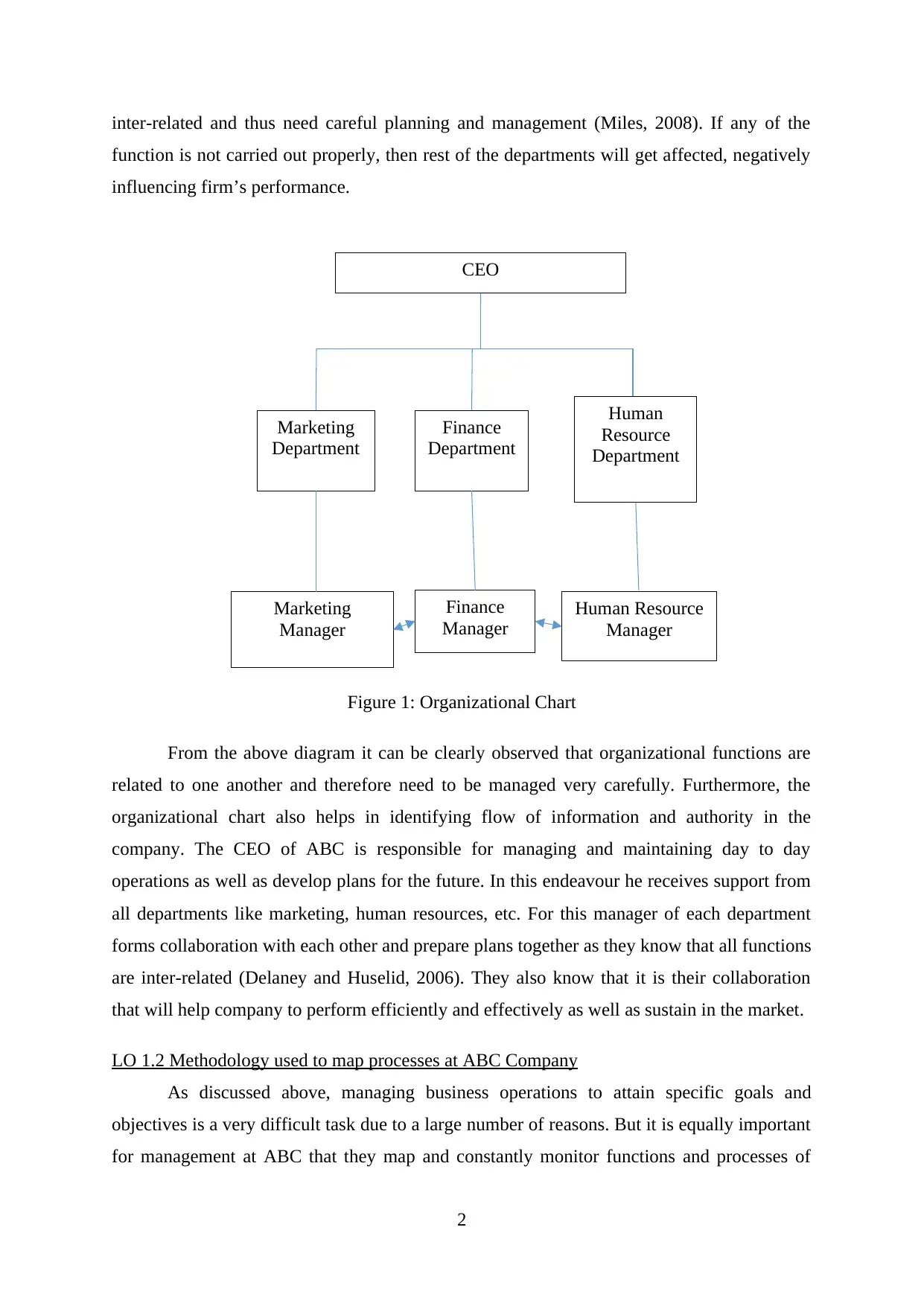
CEO
Marketing
Department
Finance
Department
Human
Resource
Department
Marketing
Manager
Finance
Manager
Human Resource
Manager
inter-related and thus need careful planning and management (Miles, 2008). If any of the
function is not carried out properly, then rest of the departments will get affected, negatively
influencing firm’s performance.
Figure 1: Organizational Chart
From the above diagram it can be clearly observed that organizational functions are
related to one another and therefore need to be managed very carefully. Furthermore, the
organizational chart also helps in identifying flow of information and authority in the
company. The CEO of ABC is responsible for managing and maintaining day to day
operations as well as develop plans for the future. In this endeavour he receives support from
all departments like marketing, human resources, etc. For this manager of each department
forms collaboration with each other and prepare plans together as they know that all functions
are inter-related (Delaney and Huselid, 2006). They also know that it is their collaboration
that will help company to perform efficiently and effectively as well as sustain in the market.
LO 1.2 Methodology used to map processes at ABC Company
As discussed above, managing business operations to attain specific goals and
objectives is a very difficult task due to a large number of reasons. But it is equally important
for management at ABC that they map and constantly monitor functions and processes of
2
Marketing
Department
Finance
Department
Human
Resource
Department
Marketing
Manager
Finance
Manager
Human Resource
Manager
inter-related and thus need careful planning and management (Miles, 2008). If any of the
function is not carried out properly, then rest of the departments will get affected, negatively
influencing firm’s performance.
Figure 1: Organizational Chart
From the above diagram it can be clearly observed that organizational functions are
related to one another and therefore need to be managed very carefully. Furthermore, the
organizational chart also helps in identifying flow of information and authority in the
company. The CEO of ABC is responsible for managing and maintaining day to day
operations as well as develop plans for the future. In this endeavour he receives support from
all departments like marketing, human resources, etc. For this manager of each department
forms collaboration with each other and prepare plans together as they know that all functions
are inter-related (Delaney and Huselid, 2006). They also know that it is their collaboration
that will help company to perform efficiently and effectively as well as sustain in the market.
LO 1.2 Methodology used to map processes at ABC Company
As discussed above, managing business operations to attain specific goals and
objectives is a very difficult task due to a large number of reasons. But it is equally important
for management at ABC that they map and constantly monitor functions and processes of
2
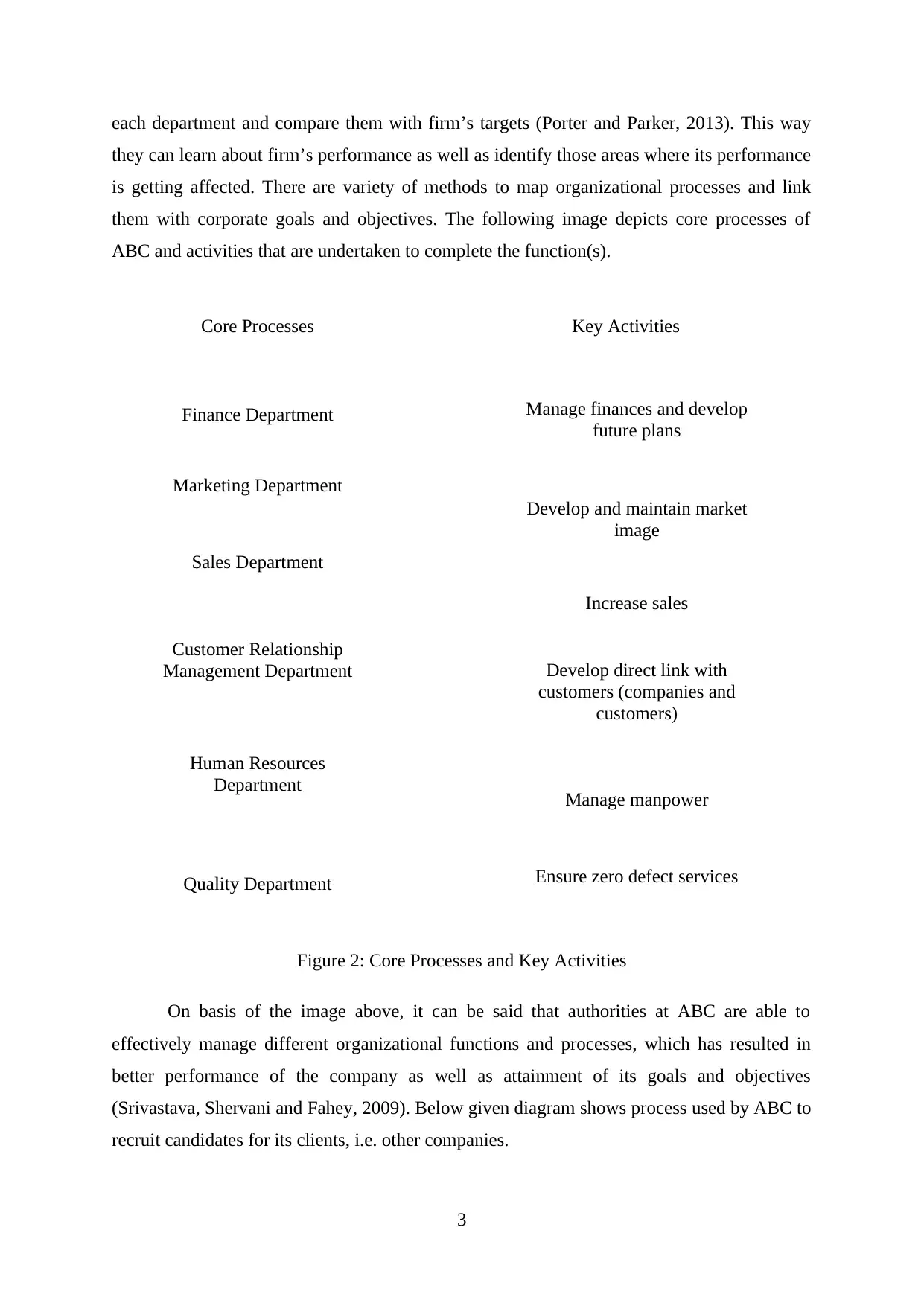
Core Processes Key Activities
Finance Department
Marketing Department
Sales Department
Customer Relationship
Management Department
Human Resources
Department
Quality Department
Manage finances and develop
future plans
Develop and maintain market
image
Increase sales
Develop direct link with
customers (companies and
customers)
Manage manpower
Ensure zero defect services
each department and compare them with firm’s targets (Porter and Parker, 2013). This way
they can learn about firm’s performance as well as identify those areas where its performance
is getting affected. There are variety of methods to map organizational processes and link
them with corporate goals and objectives. The following image depicts core processes of
ABC and activities that are undertaken to complete the function(s).
Figure 2: Core Processes and Key Activities
On basis of the image above, it can be said that authorities at ABC are able to
effectively manage different organizational functions and processes, which has resulted in
better performance of the company as well as attainment of its goals and objectives
(Srivastava, Shervani and Fahey, 2009). Below given diagram shows process used by ABC to
recruit candidates for its clients, i.e. other companies.
3
Finance Department
Marketing Department
Sales Department
Customer Relationship
Management Department
Human Resources
Department
Quality Department
Manage finances and develop
future plans
Develop and maintain market
image
Increase sales
Develop direct link with
customers (companies and
customers)
Manage manpower
Ensure zero defect services
each department and compare them with firm’s targets (Porter and Parker, 2013). This way
they can learn about firm’s performance as well as identify those areas where its performance
is getting affected. There are variety of methods to map organizational processes and link
them with corporate goals and objectives. The following image depicts core processes of
ABC and activities that are undertaken to complete the function(s).
Figure 2: Core Processes and Key Activities
On basis of the image above, it can be said that authorities at ABC are able to
effectively manage different organizational functions and processes, which has resulted in
better performance of the company as well as attainment of its goals and objectives
(Srivastava, Shervani and Fahey, 2009). Below given diagram shows process used by ABC to
recruit candidates for its clients, i.e. other companies.
3
⊘ This is a preview!⊘
Do you want full access?
Subscribe today to unlock all pages.

Trusted by 1+ million students worldwide
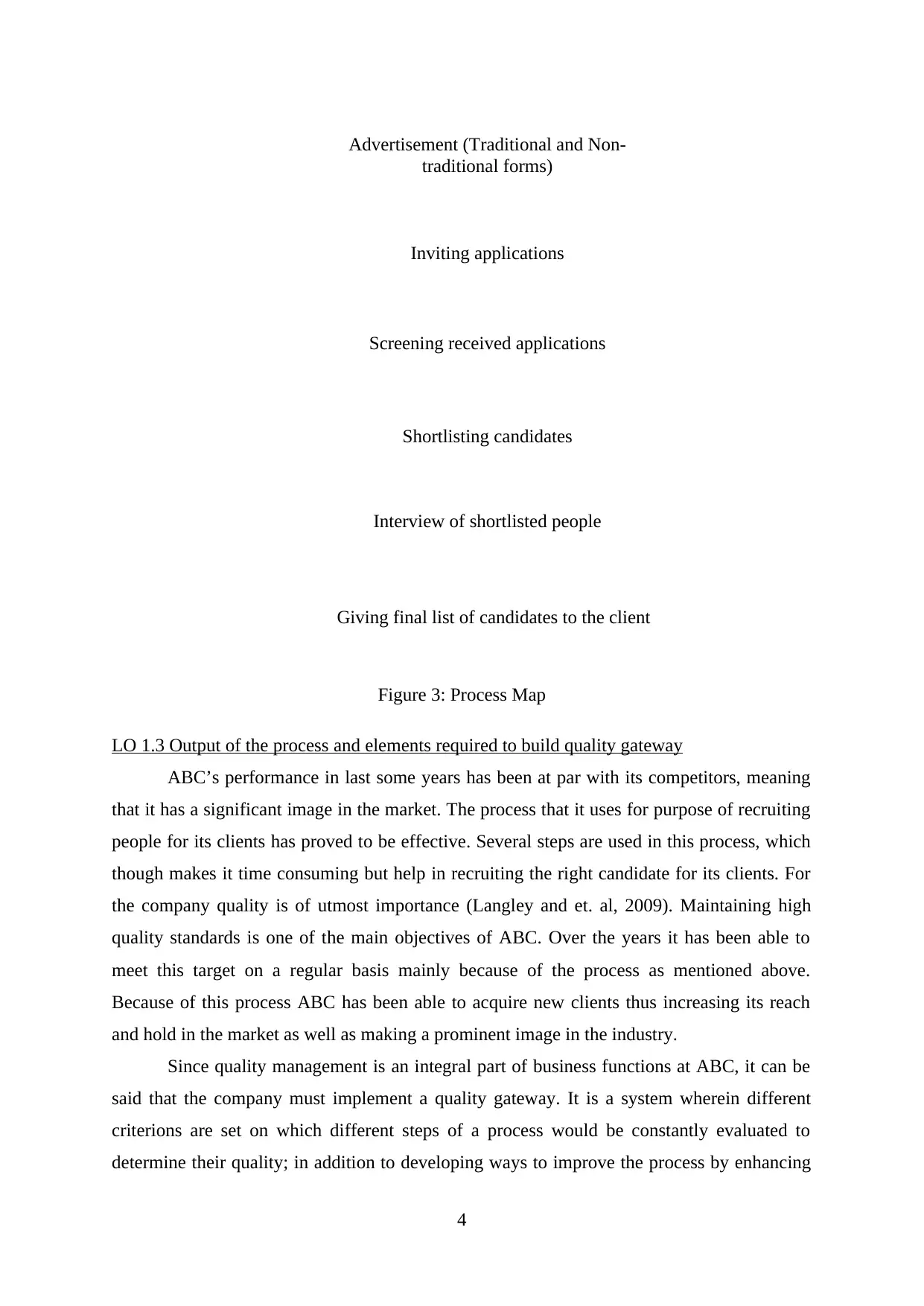
Advertisement (Traditional and Non-
traditional forms)
Inviting applications
Screening received applications
Shortlisting candidates
Interview of shortlisted people
Giving final list of candidates to the client
Figure 3: Process Map
LO 1.3 Output of the process and elements required to build quality gateway
ABC’s performance in last some years has been at par with its competitors, meaning
that it has a significant image in the market. The process that it uses for purpose of recruiting
people for its clients has proved to be effective. Several steps are used in this process, which
though makes it time consuming but help in recruiting the right candidate for its clients. For
the company quality is of utmost importance (Langley and et. al, 2009). Maintaining high
quality standards is one of the main objectives of ABC. Over the years it has been able to
meet this target on a regular basis mainly because of the process as mentioned above.
Because of this process ABC has been able to acquire new clients thus increasing its reach
and hold in the market as well as making a prominent image in the industry.
Since quality management is an integral part of business functions at ABC, it can be
said that the company must implement a quality gateway. It is a system wherein different
criterions are set on which different steps of a process would be constantly evaluated to
determine their quality; in addition to developing ways to improve the process by enhancing
4
traditional forms)
Inviting applications
Screening received applications
Shortlisting candidates
Interview of shortlisted people
Giving final list of candidates to the client
Figure 3: Process Map
LO 1.3 Output of the process and elements required to build quality gateway
ABC’s performance in last some years has been at par with its competitors, meaning
that it has a significant image in the market. The process that it uses for purpose of recruiting
people for its clients has proved to be effective. Several steps are used in this process, which
though makes it time consuming but help in recruiting the right candidate for its clients. For
the company quality is of utmost importance (Langley and et. al, 2009). Maintaining high
quality standards is one of the main objectives of ABC. Over the years it has been able to
meet this target on a regular basis mainly because of the process as mentioned above.
Because of this process ABC has been able to acquire new clients thus increasing its reach
and hold in the market as well as making a prominent image in the industry.
Since quality management is an integral part of business functions at ABC, it can be
said that the company must implement a quality gateway. It is a system wherein different
criterions are set on which different steps of a process would be constantly evaluated to
determine their quality; in addition to developing ways to improve the process by enhancing
4
Paraphrase This Document
Need a fresh take? Get an instant paraphrase of this document with our AI Paraphraser
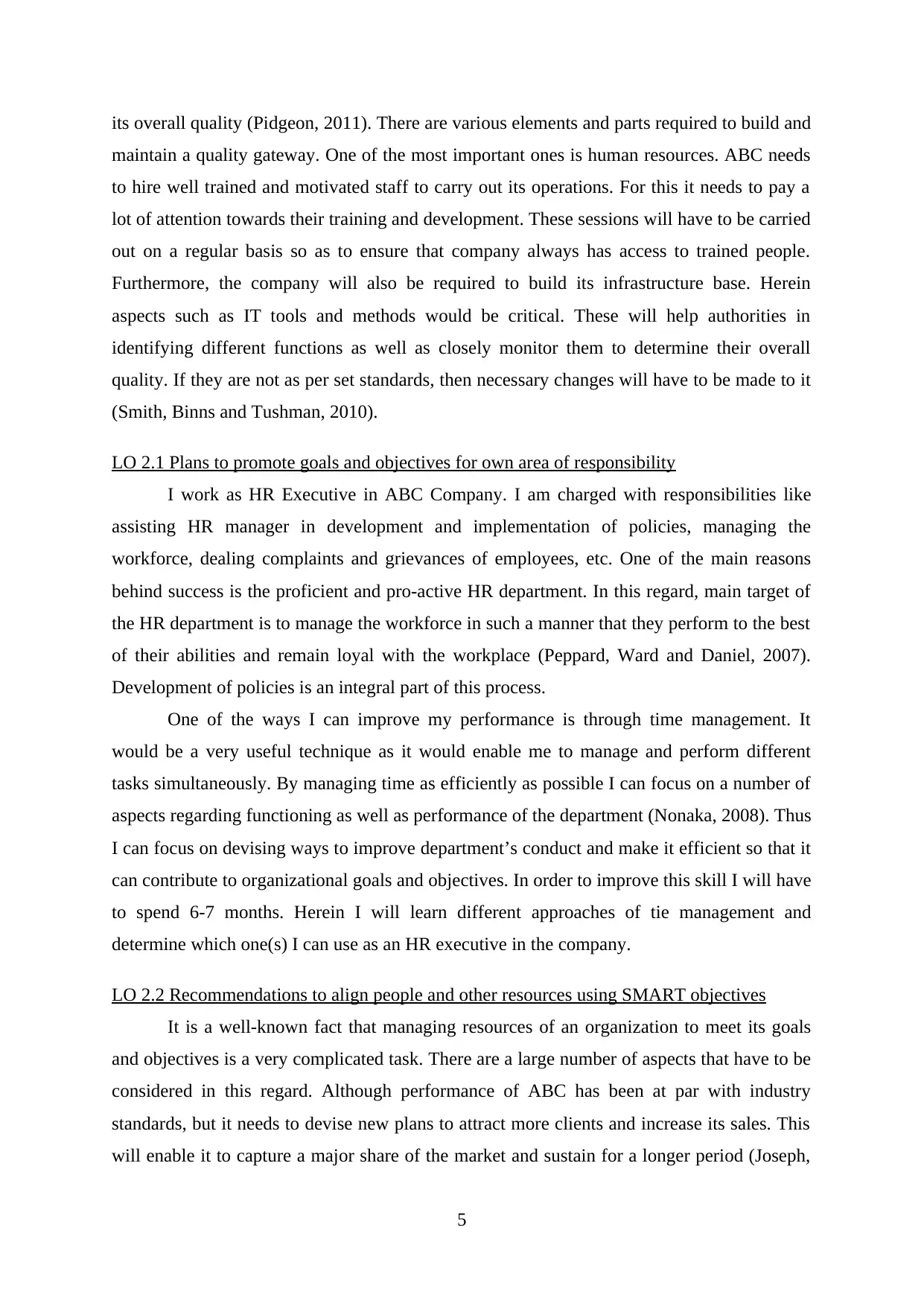
its overall quality (Pidgeon, 2011). There are various elements and parts required to build and
maintain a quality gateway. One of the most important ones is human resources. ABC needs
to hire well trained and motivated staff to carry out its operations. For this it needs to pay a
lot of attention towards their training and development. These sessions will have to be carried
out on a regular basis so as to ensure that company always has access to trained people.
Furthermore, the company will also be required to build its infrastructure base. Herein
aspects such as IT tools and methods would be critical. These will help authorities in
identifying different functions as well as closely monitor them to determine their overall
quality. If they are not as per set standards, then necessary changes will have to be made to it
(Smith, Binns and Tushman, 2010).
LO 2.1 Plans to promote goals and objectives for own area of responsibility
I work as HR Executive in ABC Company. I am charged with responsibilities like
assisting HR manager in development and implementation of policies, managing the
workforce, dealing complaints and grievances of employees, etc. One of the main reasons
behind success is the proficient and pro-active HR department. In this regard, main target of
the HR department is to manage the workforce in such a manner that they perform to the best
of their abilities and remain loyal with the workplace (Peppard, Ward and Daniel, 2007).
Development of policies is an integral part of this process.
One of the ways I can improve my performance is through time management. It
would be a very useful technique as it would enable me to manage and perform different
tasks simultaneously. By managing time as efficiently as possible I can focus on a number of
aspects regarding functioning as well as performance of the department (Nonaka, 2008). Thus
I can focus on devising ways to improve department’s conduct and make it efficient so that it
can contribute to organizational goals and objectives. In order to improve this skill I will have
to spend 6-7 months. Herein I will learn different approaches of tie management and
determine which one(s) I can use as an HR executive in the company.
LO 2.2 Recommendations to align people and other resources using SMART objectives
It is a well-known fact that managing resources of an organization to meet its goals
and objectives is a very complicated task. There are a large number of aspects that have to be
considered in this regard. Although performance of ABC has been at par with industry
standards, but it needs to devise new plans to attract more clients and increase its sales. This
will enable it to capture a major share of the market and sustain for a longer period (Joseph,
5
maintain a quality gateway. One of the most important ones is human resources. ABC needs
to hire well trained and motivated staff to carry out its operations. For this it needs to pay a
lot of attention towards their training and development. These sessions will have to be carried
out on a regular basis so as to ensure that company always has access to trained people.
Furthermore, the company will also be required to build its infrastructure base. Herein
aspects such as IT tools and methods would be critical. These will help authorities in
identifying different functions as well as closely monitor them to determine their overall
quality. If they are not as per set standards, then necessary changes will have to be made to it
(Smith, Binns and Tushman, 2010).
LO 2.1 Plans to promote goals and objectives for own area of responsibility
I work as HR Executive in ABC Company. I am charged with responsibilities like
assisting HR manager in development and implementation of policies, managing the
workforce, dealing complaints and grievances of employees, etc. One of the main reasons
behind success is the proficient and pro-active HR department. In this regard, main target of
the HR department is to manage the workforce in such a manner that they perform to the best
of their abilities and remain loyal with the workplace (Peppard, Ward and Daniel, 2007).
Development of policies is an integral part of this process.
One of the ways I can improve my performance is through time management. It
would be a very useful technique as it would enable me to manage and perform different
tasks simultaneously. By managing time as efficiently as possible I can focus on a number of
aspects regarding functioning as well as performance of the department (Nonaka, 2008). Thus
I can focus on devising ways to improve department’s conduct and make it efficient so that it
can contribute to organizational goals and objectives. In order to improve this skill I will have
to spend 6-7 months. Herein I will learn different approaches of tie management and
determine which one(s) I can use as an HR executive in the company.
LO 2.2 Recommendations to align people and other resources using SMART objectives
It is a well-known fact that managing resources of an organization to meet its goals
and objectives is a very complicated task. There are a large number of aspects that have to be
considered in this regard. Although performance of ABC has been at par with industry
standards, but it needs to devise new plans to attract more clients and increase its sales. This
will enable it to capture a major share of the market and sustain for a longer period (Joseph,
5
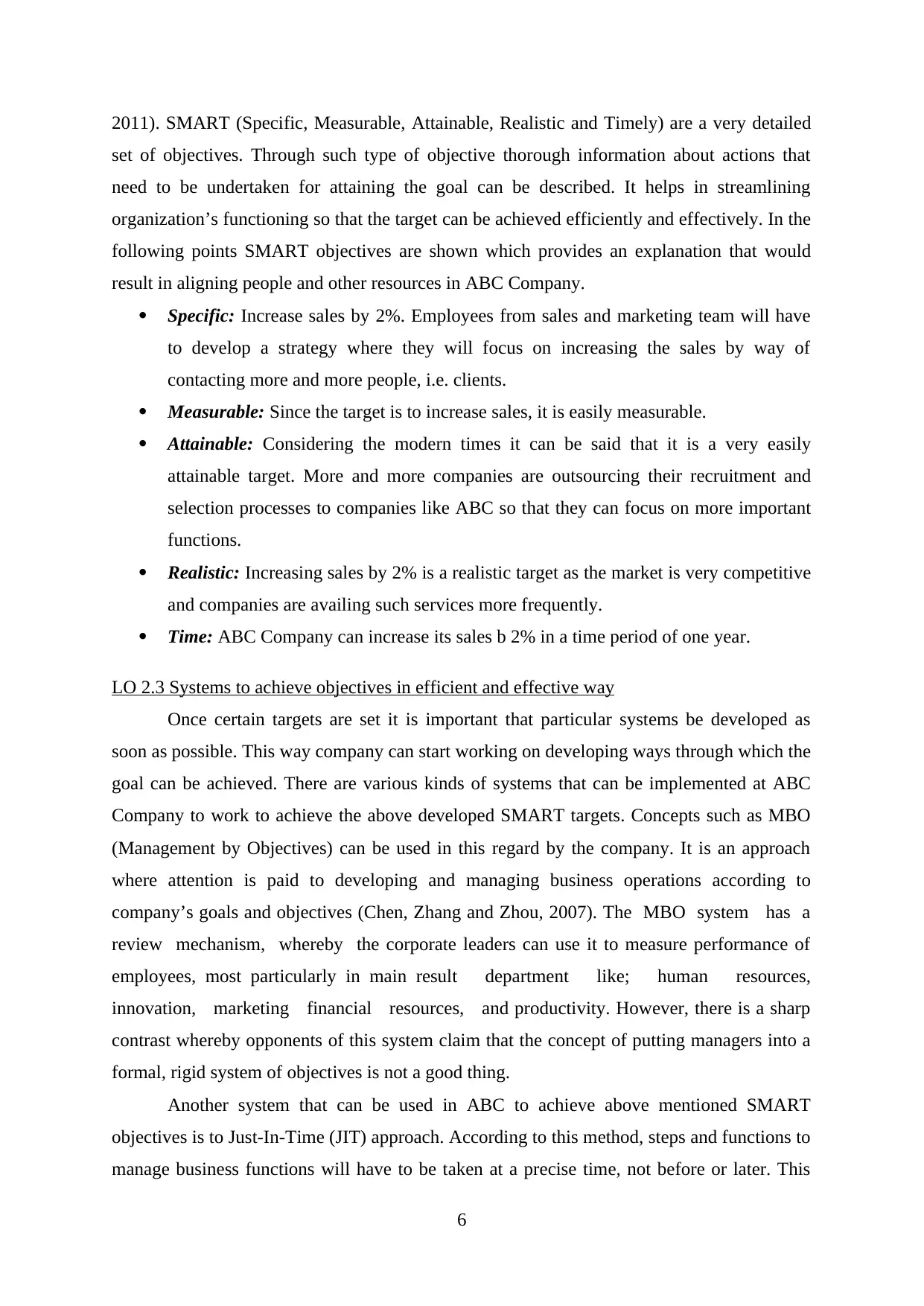
2011). SMART (Specific, Measurable, Attainable, Realistic and Timely) are a very detailed
set of objectives. Through such type of objective thorough information about actions that
need to be undertaken for attaining the goal can be described. It helps in streamlining
organization’s functioning so that the target can be achieved efficiently and effectively. In the
following points SMART objectives are shown which provides an explanation that would
result in aligning people and other resources in ABC Company.
Specific: Increase sales by 2%. Employees from sales and marketing team will have
to develop a strategy where they will focus on increasing the sales by way of
contacting more and more people, i.e. clients.
Measurable: Since the target is to increase sales, it is easily measurable.
Attainable: Considering the modern times it can be said that it is a very easily
attainable target. More and more companies are outsourcing their recruitment and
selection processes to companies like ABC so that they can focus on more important
functions.
Realistic: Increasing sales by 2% is a realistic target as the market is very competitive
and companies are availing such services more frequently.
Time: ABC Company can increase its sales b 2% in a time period of one year.
LO 2.3 Systems to achieve objectives in efficient and effective way
Once certain targets are set it is important that particular systems be developed as
soon as possible. This way company can start working on developing ways through which the
goal can be achieved. There are various kinds of systems that can be implemented at ABC
Company to work to achieve the above developed SMART targets. Concepts such as MBO
(Management by Objectives) can be used in this regard by the company. It is an approach
where attention is paid to developing and managing business operations according to
company’s goals and objectives (Chen, Zhang and Zhou, 2007). The MBO system has a
review mechanism, whereby the corporate leaders can use it to measure performance of
employees, most particularly in main result department like; human resources,
innovation, marketing financial resources, and productivity. However, there is a sharp
contrast whereby opponents of this system claim that the concept of putting managers into a
formal, rigid system of objectives is not a good thing.
Another system that can be used in ABC to achieve above mentioned SMART
objectives is to Just-In-Time (JIT) approach. According to this method, steps and functions to
manage business functions will have to be taken at a precise time, not before or later. This
6
set of objectives. Through such type of objective thorough information about actions that
need to be undertaken for attaining the goal can be described. It helps in streamlining
organization’s functioning so that the target can be achieved efficiently and effectively. In the
following points SMART objectives are shown which provides an explanation that would
result in aligning people and other resources in ABC Company.
Specific: Increase sales by 2%. Employees from sales and marketing team will have
to develop a strategy where they will focus on increasing the sales by way of
contacting more and more people, i.e. clients.
Measurable: Since the target is to increase sales, it is easily measurable.
Attainable: Considering the modern times it can be said that it is a very easily
attainable target. More and more companies are outsourcing their recruitment and
selection processes to companies like ABC so that they can focus on more important
functions.
Realistic: Increasing sales by 2% is a realistic target as the market is very competitive
and companies are availing such services more frequently.
Time: ABC Company can increase its sales b 2% in a time period of one year.
LO 2.3 Systems to achieve objectives in efficient and effective way
Once certain targets are set it is important that particular systems be developed as
soon as possible. This way company can start working on developing ways through which the
goal can be achieved. There are various kinds of systems that can be implemented at ABC
Company to work to achieve the above developed SMART targets. Concepts such as MBO
(Management by Objectives) can be used in this regard by the company. It is an approach
where attention is paid to developing and managing business operations according to
company’s goals and objectives (Chen, Zhang and Zhou, 2007). The MBO system has a
review mechanism, whereby the corporate leaders can use it to measure performance of
employees, most particularly in main result department like; human resources,
innovation, marketing financial resources, and productivity. However, there is a sharp
contrast whereby opponents of this system claim that the concept of putting managers into a
formal, rigid system of objectives is not a good thing.
Another system that can be used in ABC to achieve above mentioned SMART
objectives is to Just-In-Time (JIT) approach. According to this method, steps and functions to
manage business functions will have to be taken at a precise time, not before or later. This
6
⊘ This is a preview!⊘
Do you want full access?
Subscribe today to unlock all pages.

Trusted by 1+ million students worldwide
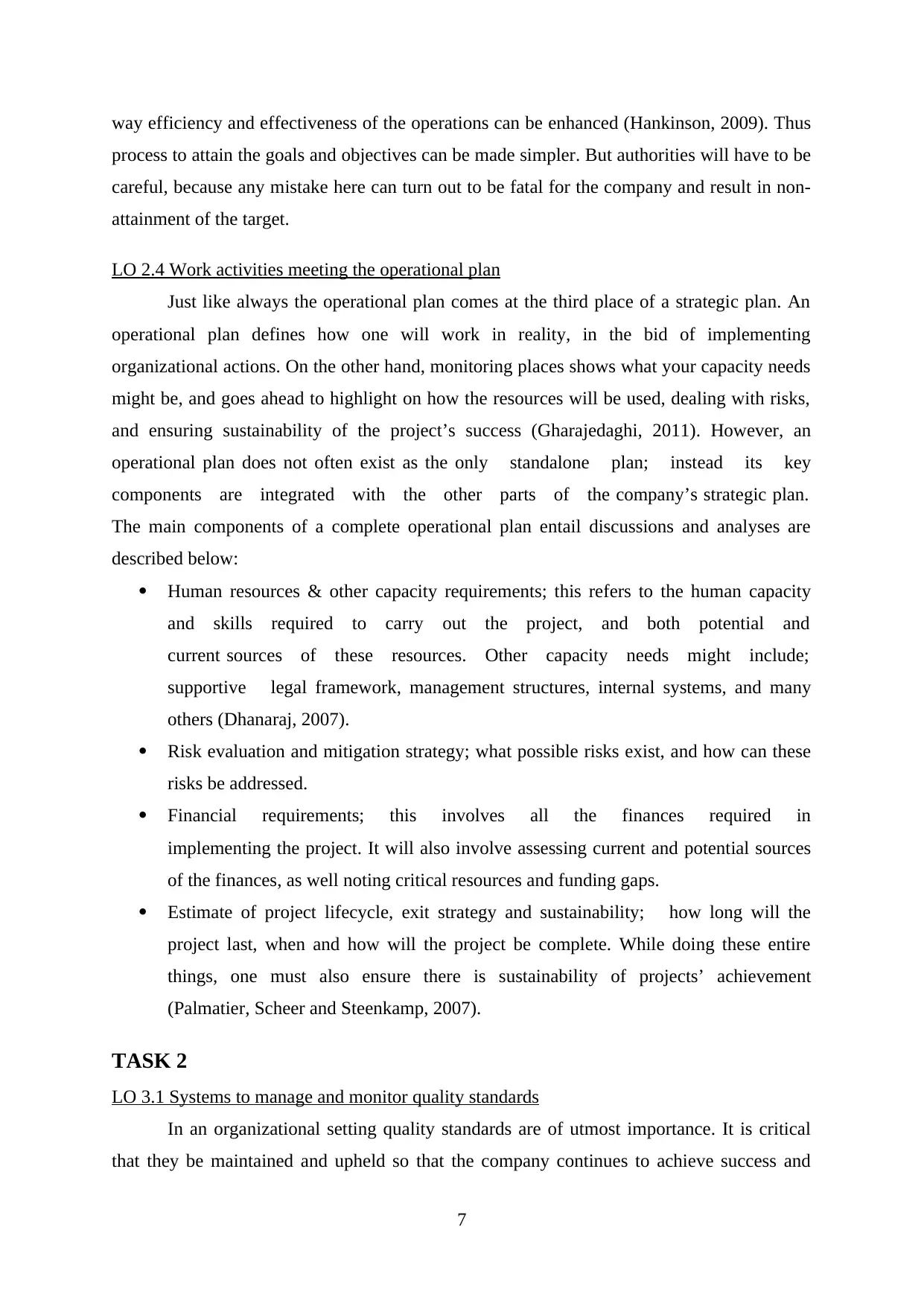
way efficiency and effectiveness of the operations can be enhanced (Hankinson, 2009). Thus
process to attain the goals and objectives can be made simpler. But authorities will have to be
careful, because any mistake here can turn out to be fatal for the company and result in non-
attainment of the target.
LO 2.4 Work activities meeting the operational plan
Just like always the operational plan comes at the third place of a strategic plan. An
operational plan defines how one will work in reality, in the bid of implementing
organizational actions. On the other hand, monitoring places shows what your capacity needs
might be, and goes ahead to highlight on how the resources will be used, dealing with risks,
and ensuring sustainability of the project’s success (Gharajedaghi, 2011). However, an
operational plan does not often exist as the only standalone plan; instead its key
components are integrated with the other parts of the company’s strategic plan.
The main components of a complete operational plan entail discussions and analyses are
described below:
Human resources & other capacity requirements; this refers to the human capacity
and skills required to carry out the project, and both potential and
current sources of these resources. Other capacity needs might include;
supportive legal framework, management structures, internal systems, and many
others (Dhanaraj, 2007).
Risk evaluation and mitigation strategy; what possible risks exist, and how can these
risks be addressed.
Financial requirements; this involves all the finances required in
implementing the project. It will also involve assessing current and potential sources
of the finances, as well noting critical resources and funding gaps.
Estimate of project lifecycle, exit strategy and sustainability; how long will the
project last, when and how will the project be complete. While doing these entire
things, one must also ensure there is sustainability of projects’ achievement
(Palmatier, Scheer and Steenkamp, 2007).
TASK 2
LO 3.1 Systems to manage and monitor quality standards
In an organizational setting quality standards are of utmost importance. It is critical
that they be maintained and upheld so that the company continues to achieve success and
7
process to attain the goals and objectives can be made simpler. But authorities will have to be
careful, because any mistake here can turn out to be fatal for the company and result in non-
attainment of the target.
LO 2.4 Work activities meeting the operational plan
Just like always the operational plan comes at the third place of a strategic plan. An
operational plan defines how one will work in reality, in the bid of implementing
organizational actions. On the other hand, monitoring places shows what your capacity needs
might be, and goes ahead to highlight on how the resources will be used, dealing with risks,
and ensuring sustainability of the project’s success (Gharajedaghi, 2011). However, an
operational plan does not often exist as the only standalone plan; instead its key
components are integrated with the other parts of the company’s strategic plan.
The main components of a complete operational plan entail discussions and analyses are
described below:
Human resources & other capacity requirements; this refers to the human capacity
and skills required to carry out the project, and both potential and
current sources of these resources. Other capacity needs might include;
supportive legal framework, management structures, internal systems, and many
others (Dhanaraj, 2007).
Risk evaluation and mitigation strategy; what possible risks exist, and how can these
risks be addressed.
Financial requirements; this involves all the finances required in
implementing the project. It will also involve assessing current and potential sources
of the finances, as well noting critical resources and funding gaps.
Estimate of project lifecycle, exit strategy and sustainability; how long will the
project last, when and how will the project be complete. While doing these entire
things, one must also ensure there is sustainability of projects’ achievement
(Palmatier, Scheer and Steenkamp, 2007).
TASK 2
LO 3.1 Systems to manage and monitor quality standards
In an organizational setting quality standards are of utmost importance. It is critical
that they be maintained and upheld so that the company continues to achieve success and
7
Paraphrase This Document
Need a fresh take? Get an instant paraphrase of this document with our AI Paraphraser
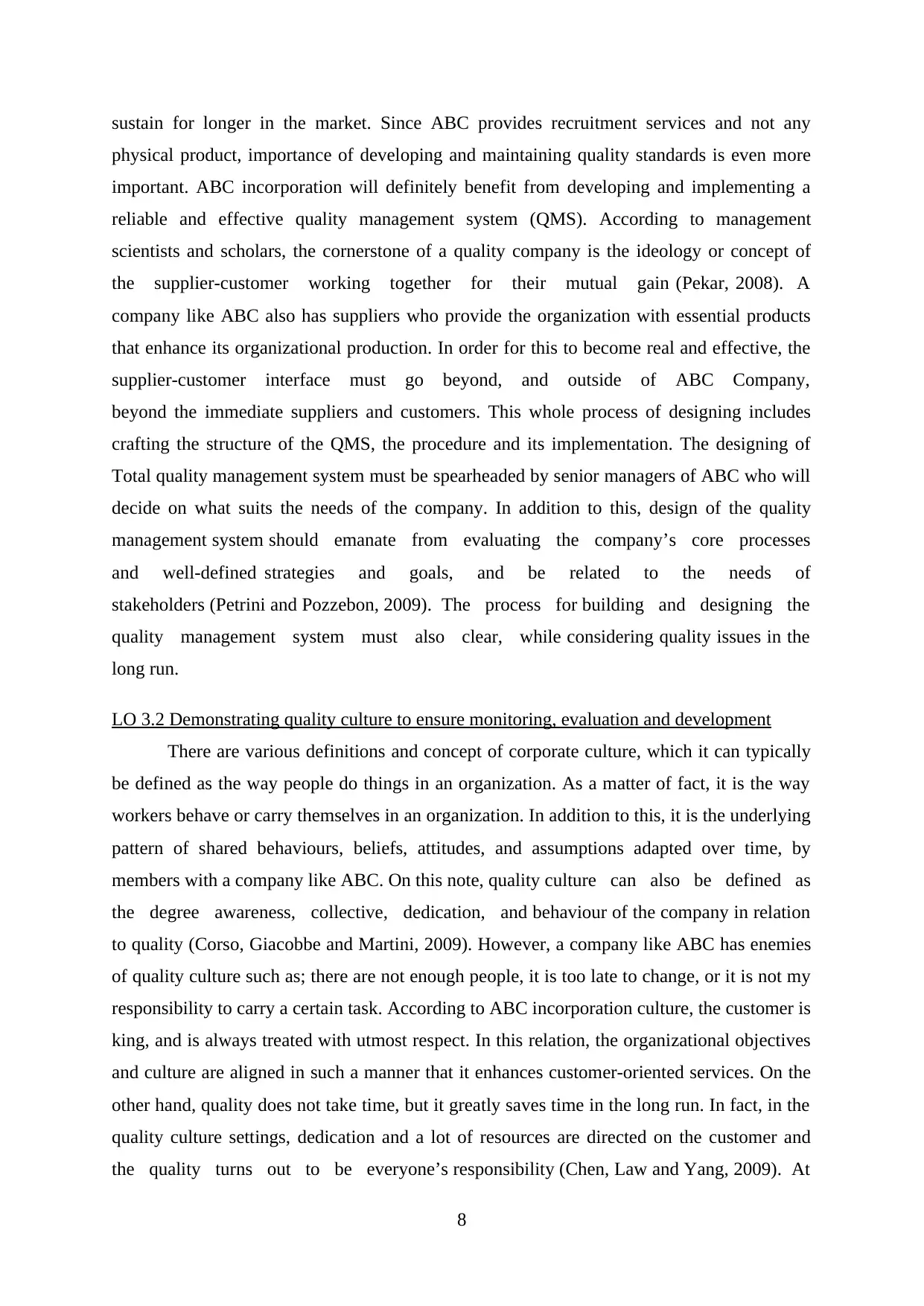
sustain for longer in the market. Since ABC provides recruitment services and not any
physical product, importance of developing and maintaining quality standards is even more
important. ABC incorporation will definitely benefit from developing and implementing a
reliable and effective quality management system (QMS). According to management
scientists and scholars, the cornerstone of a quality company is the ideology or concept of
the supplier-customer working together for their mutual gain (Pekar, 2008). A
company like ABC also has suppliers who provide the organization with essential products
that enhance its organizational production. In order for this to become real and effective, the
supplier-customer interface must go beyond, and outside of ABC Company,
beyond the immediate suppliers and customers. This whole process of designing includes
crafting the structure of the QMS, the procedure and its implementation. The designing of
Total quality management system must be spearheaded by senior managers of ABC who will
decide on what suits the needs of the company. In addition to this, design of the quality
management system should emanate from evaluating the company’s core processes
and well-defined strategies and goals, and be related to the needs of
stakeholders (Petrini and Pozzebon, 2009). The process for building and designing the
quality management system must also clear, while considering quality issues in the
long run.
LO 3.2 Demonstrating quality culture to ensure monitoring, evaluation and development
There are various definitions and concept of corporate culture, which it can typically
be defined as the way people do things in an organization. As a matter of fact, it is the way
workers behave or carry themselves in an organization. In addition to this, it is the underlying
pattern of shared behaviours, beliefs, attitudes, and assumptions adapted over time, by
members with a company like ABC. On this note, quality culture can also be defined as
the degree awareness, collective, dedication, and behaviour of the company in relation
to quality (Corso, Giacobbe and Martini, 2009). However, a company like ABC has enemies
of quality culture such as; there are not enough people, it is too late to change, or it is not my
responsibility to carry a certain task. According to ABC incorporation culture, the customer is
king, and is always treated with utmost respect. In this relation, the organizational objectives
and culture are aligned in such a manner that it enhances customer-oriented services. On the
other hand, quality does not take time, but it greatly saves time in the long run. In fact, in the
quality culture settings, dedication and a lot of resources are directed on the customer and
the quality turns out to be everyone’s responsibility (Chen, Law and Yang, 2009). At
8
physical product, importance of developing and maintaining quality standards is even more
important. ABC incorporation will definitely benefit from developing and implementing a
reliable and effective quality management system (QMS). According to management
scientists and scholars, the cornerstone of a quality company is the ideology or concept of
the supplier-customer working together for their mutual gain (Pekar, 2008). A
company like ABC also has suppliers who provide the organization with essential products
that enhance its organizational production. In order for this to become real and effective, the
supplier-customer interface must go beyond, and outside of ABC Company,
beyond the immediate suppliers and customers. This whole process of designing includes
crafting the structure of the QMS, the procedure and its implementation. The designing of
Total quality management system must be spearheaded by senior managers of ABC who will
decide on what suits the needs of the company. In addition to this, design of the quality
management system should emanate from evaluating the company’s core processes
and well-defined strategies and goals, and be related to the needs of
stakeholders (Petrini and Pozzebon, 2009). The process for building and designing the
quality management system must also clear, while considering quality issues in the
long run.
LO 3.2 Demonstrating quality culture to ensure monitoring, evaluation and development
There are various definitions and concept of corporate culture, which it can typically
be defined as the way people do things in an organization. As a matter of fact, it is the way
workers behave or carry themselves in an organization. In addition to this, it is the underlying
pattern of shared behaviours, beliefs, attitudes, and assumptions adapted over time, by
members with a company like ABC. On this note, quality culture can also be defined as
the degree awareness, collective, dedication, and behaviour of the company in relation
to quality (Corso, Giacobbe and Martini, 2009). However, a company like ABC has enemies
of quality culture such as; there are not enough people, it is too late to change, or it is not my
responsibility to carry a certain task. According to ABC incorporation culture, the customer is
king, and is always treated with utmost respect. In this relation, the organizational objectives
and culture are aligned in such a manner that it enhances customer-oriented services. On the
other hand, quality does not take time, but it greatly saves time in the long run. In fact, in the
quality culture settings, dedication and a lot of resources are directed on the customer and
the quality turns out to be everyone’s responsibility (Chen, Law and Yang, 2009). At
8
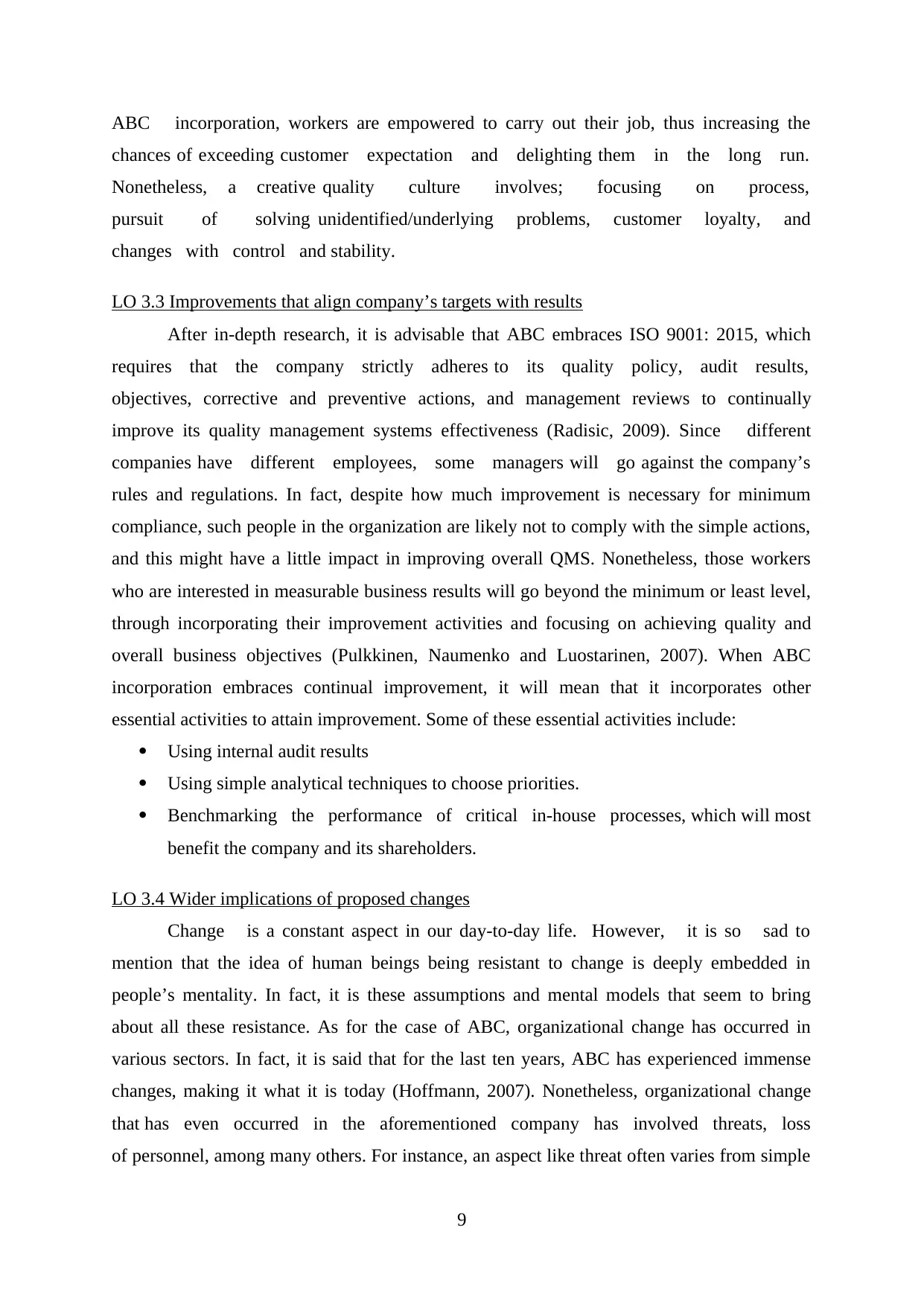
ABC incorporation, workers are empowered to carry out their job, thus increasing the
chances of exceeding customer expectation and delighting them in the long run.
Nonetheless, a creative quality culture involves; focusing on process,
pursuit of solving unidentified/underlying problems, customer loyalty, and
changes with control and stability.
LO 3.3 Improvements that align company’s targets with results
After in-depth research, it is advisable that ABC embraces ISO 9001: 2015, which
requires that the company strictly adheres to its quality policy, audit results,
objectives, corrective and preventive actions, and management reviews to continually
improve its quality management systems effectiveness (Radisic, 2009). Since different
companies have different employees, some managers will go against the company’s
rules and regulations. In fact, despite how much improvement is necessary for minimum
compliance, such people in the organization are likely not to comply with the simple actions,
and this might have a little impact in improving overall QMS. Nonetheless, those workers
who are interested in measurable business results will go beyond the minimum or least level,
through incorporating their improvement activities and focusing on achieving quality and
overall business objectives (Pulkkinen, Naumenko and Luostarinen, 2007). When ABC
incorporation embraces continual improvement, it will mean that it incorporates other
essential activities to attain improvement. Some of these essential activities include:
Using internal audit results
Using simple analytical techniques to choose priorities.
Benchmarking the performance of critical in-house processes, which will most
benefit the company and its shareholders.
LO 3.4 Wider implications of proposed changes
Change is a constant aspect in our day-to-day life. However, it is so sad to
mention that the idea of human beings being resistant to change is deeply embedded in
people’s mentality. In fact, it is these assumptions and mental models that seem to bring
about all these resistance. As for the case of ABC, organizational change has occurred in
various sectors. In fact, it is said that for the last ten years, ABC has experienced immense
changes, making it what it is today (Hoffmann, 2007). Nonetheless, organizational change
that has even occurred in the aforementioned company has involved threats, loss
of personnel, among many others. For instance, an aspect like threat often varies from simple
9
chances of exceeding customer expectation and delighting them in the long run.
Nonetheless, a creative quality culture involves; focusing on process,
pursuit of solving unidentified/underlying problems, customer loyalty, and
changes with control and stability.
LO 3.3 Improvements that align company’s targets with results
After in-depth research, it is advisable that ABC embraces ISO 9001: 2015, which
requires that the company strictly adheres to its quality policy, audit results,
objectives, corrective and preventive actions, and management reviews to continually
improve its quality management systems effectiveness (Radisic, 2009). Since different
companies have different employees, some managers will go against the company’s
rules and regulations. In fact, despite how much improvement is necessary for minimum
compliance, such people in the organization are likely not to comply with the simple actions,
and this might have a little impact in improving overall QMS. Nonetheless, those workers
who are interested in measurable business results will go beyond the minimum or least level,
through incorporating their improvement activities and focusing on achieving quality and
overall business objectives (Pulkkinen, Naumenko and Luostarinen, 2007). When ABC
incorporation embraces continual improvement, it will mean that it incorporates other
essential activities to attain improvement. Some of these essential activities include:
Using internal audit results
Using simple analytical techniques to choose priorities.
Benchmarking the performance of critical in-house processes, which will most
benefit the company and its shareholders.
LO 3.4 Wider implications of proposed changes
Change is a constant aspect in our day-to-day life. However, it is so sad to
mention that the idea of human beings being resistant to change is deeply embedded in
people’s mentality. In fact, it is these assumptions and mental models that seem to bring
about all these resistance. As for the case of ABC, organizational change has occurred in
various sectors. In fact, it is said that for the last ten years, ABC has experienced immense
changes, making it what it is today (Hoffmann, 2007). Nonetheless, organizational change
that has even occurred in the aforementioned company has involved threats, loss
of personnel, among many others. For instance, an aspect like threat often varies from simple
9
⊘ This is a preview!⊘
Do you want full access?
Subscribe today to unlock all pages.

Trusted by 1+ million students worldwide
1 out of 17
Related Documents
Your All-in-One AI-Powered Toolkit for Academic Success.
+13062052269
info@desklib.com
Available 24*7 on WhatsApp / Email
![[object Object]](/_next/static/media/star-bottom.7253800d.svg)
Unlock your academic potential
Copyright © 2020–2025 A2Z Services. All Rights Reserved. Developed and managed by ZUCOL.





